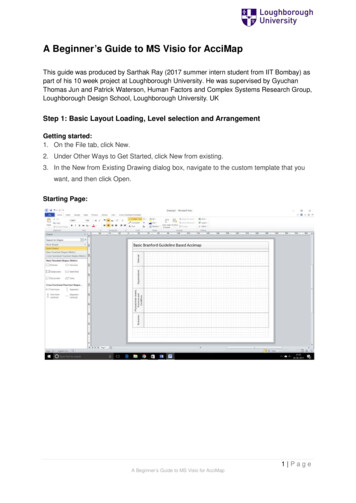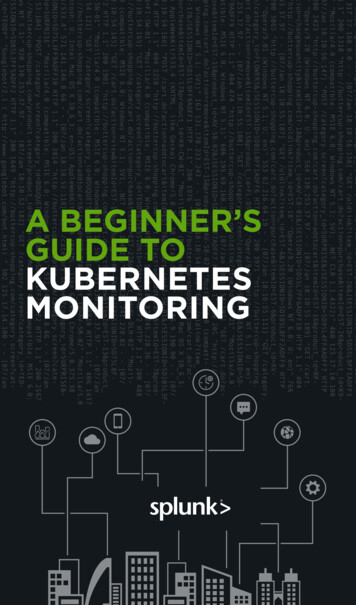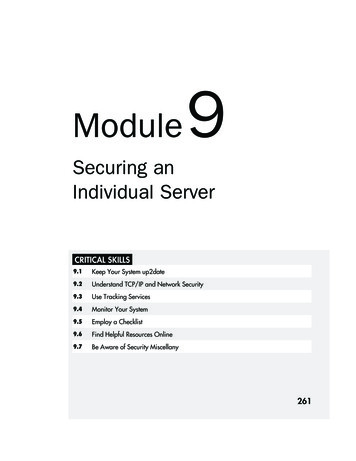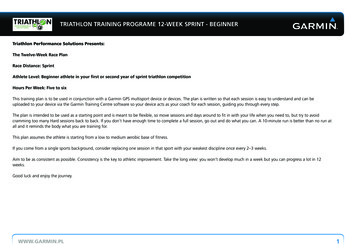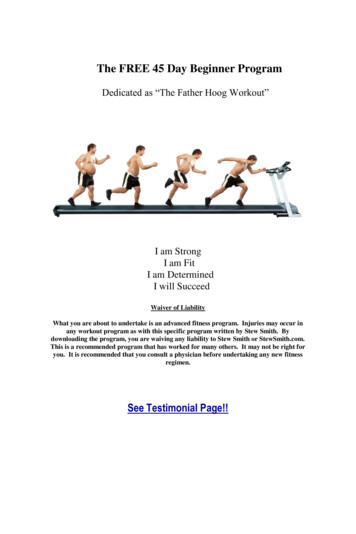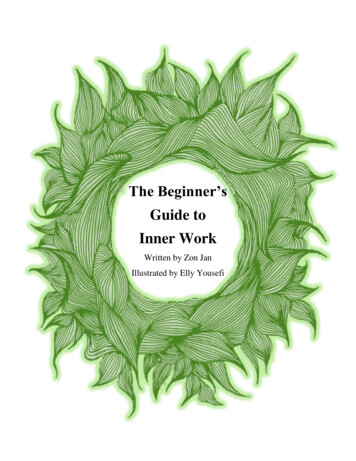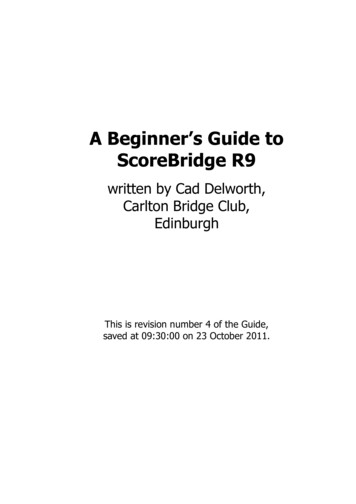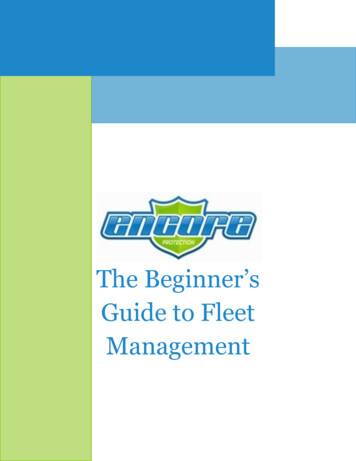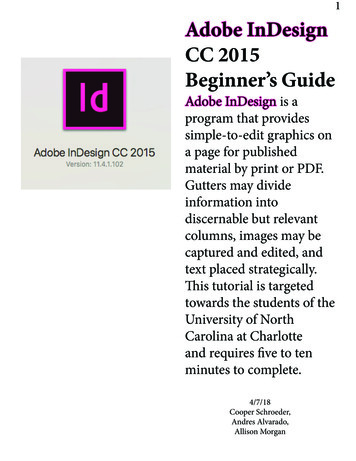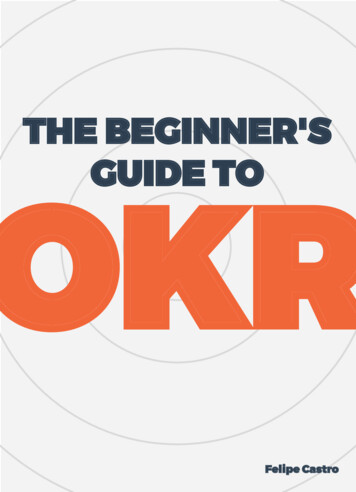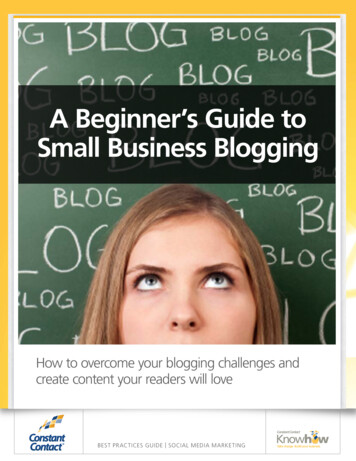
Transcription
A Beginner’s Guide toSmall Business BloggingHow to overcome your blogging challenges andcreate content your readers will love 2013 Copyright Constant Contact, Inc. 13-3450BEST PRACTICES Guide Social Media MARKETING
So you’ve been thinking about starting a blog for your small business?That’s great news! Blogging is a great way to tell your business’s story and, if doneright, can help take your online marketing to a whole new level.But as you have probably figured out, creating a successful blog also comes withcertain challenges.This is especially true if you’re just getting started. Whether it’s coming up withtopics to write about or figuring out how to find the time to actually do it—thereare certain obstacles you’ll need to overcome if you want to make your blog asuccess.The good news is we’ve got the resources you need to do it.Here’s what we’ll cover Why You Should Start a Blog for Your Small Business . How to Create Great Content (Even if You Think You’re a Horrible Writer) . 8 Things You’ll Want to Consider When Starting a Blog for Your Business Where You Should Promote Your Blog to Get More Readers Simple Strategies for Creating Content Your Audience Will Love to ReadRead it from start to finish or find the help that’s right for you. Either way, we hope this guidecan take some of the anxiety out of getting started and give you the tools you need to makeyour blog a success.1Insight provided by Constant Contact KnowHowwww.constantcontact.com/learning-center
A Beginner’s Guide to Small Business BloggingWhy You Should Start a Blog for Your Small BusinessIt’s no secret that small businesses have a lot on their plateswhen it comes to online marketing. Whether it’s keeping upwith Facebook, Twitter, LinkedIn, or Pinterest or coming upwith content for your latest email newsletter—it’s easy to getoverwhelmed.But starting a blog for your business doesn’t need to be anadded burden to your online marketing strategy. It’s actuallyquite the opposite. Creating a blog can help alleviate some ofyour biggest marketing pain points.When you look at the stuff you’re already doing on sites likeFacebook and Twitter or with your email marketing, isn’tcoming up with great content already one of your biggestmarketing challenges?Having a blog allows you create that content in a centrallocation and share it with subscribers, fans, and followerswithout any additional work. Not only will you have theflexibility to create better, more engaging content than a typicalupdate on social media, but you’ll also have the opportunity tobusinesses when it comes to getting their content discovered inget more value out of every piece of content you create.Google searches.What type of value can having a blog bring to your business?For those businesses already using a blog for their business, thisHere are a few examples:is a huge opportunity and could go a long way in helping yourbusiness get discovered online. For those businesses that haveBlogging can help you get discovered onlinebeen on the fence about starting a blog, there’s never been aNow, more than ever, blogging has the potential to help yourbetter time than now.business get discovered by an online audience.If you’ve been searching Google lately, then you’ve probablynoticed that some results have a picture next to them. That’sa sign that the author has integrated Google Authorship withtheir blog.Blogging matters because you matterAs much as your customers love your brand, they really loveyou. And since customer relationships are the single biggestadvantage small businesses have over their large competitors,blogging is an invaluable way for potential customers to get toGoogle Authorship essentially links the content you publishknow, like, and trust you—while also deepening connectionson your blog to your Google profile. This link between thewith existing customers.author and the content is designed to level the playing field for2Insight provided by Constant Contact KnowHowwww.constantcontact.com/learning-center
A Beginner’s Guide to Small Business BloggingBlogging lets you personalize your businessYour “About Us” page is great for expressing your company’smain values, but a blog goes a step further by personalizingyour ideas. The huge benefit of a blog is that it humanizes yourbusiness—making your company more engaging, relatable, andtrustworthy.Adding a blog to your website is like a personal invitation foryour customers to get to know you better. By making yourselfmore available to them, your bond will become even stronger.Blogging allows you to easily keep peopleinformedIt’s important to keep your customers up-to-date on any recentdevelopments about you and your business. Even if you’realready using social media for quick updates, a blog will giveyou the space you need to go beyond the basic day-to-dayhappenings.Whether you’re sharing industry expertise, or just a personalanecdote, your posts show your true dedication to your businessGet serious about creating great content.For businesses that are serious about creating great content, having a blog is more important today than ever before.It allows you to communicate your values as an organization. It also enables you to showcase your own expertise and share yourexperience as a business owner—topics which fit perfectly into your email marketing campaigns.Overall, it allows you to humanize your marketing by communicating with your audience as a person with real thoughts, real advice,and real insights.In the next section we’ll take a look at some of the things you’ll need to consider when you’re ready to get started!Tweet it! 4 Benefits of Starting a Blog for YourSmall Business3Insight provided by Constant Contact KnowHowwww.constantcontact.com/learning-center
A Beginner’s Guide to Small Business Blogging8 Things You Need to Consider When Starting a Blog for YourSmall BusinessThe reality is that starting a blog isn’t always as simple as just wanting to do it. For a lot of people, overcoming the anxiety of gettingstarted is the hardest part of the entire process.If you’re serious about getting started, here are 8 things you’ll want to consider:1. Why are you creating a blog?This will not only put your content in front of a wider audienceYou understand what a blog can do for small businesses as awhole, but what can a blog do for your business in particular?but will also be valuable for boosting your presence on searchMore importantly, what added benefit will having a blog foryour business bring to the people who are reading it?4. How frequently will you be able to post?Identify your goals from the start and let that guide the rest ofyour decisions.2. Who are you going to be speaking to?What you decide to talk about on your blog will depend entirelyon who you’re creating content for.Who are the people that are going to be reading your blog?What type of knowledge can you share with them? What arethe questions they need answered?Our blog for example, is all about providing helpful insight andpractical advice for small businesses and nonprofits that areinterested in online marketing. Every piece of content we createis written with that audience in mind.Identify your target audience before coming up with ideas ofwhat you actually want to create.engines like Google.Similiar to all the stuff you’re already doing to market yourbusiness online, frequency will need to be an importantconsideration when starting your blog.But, if you try to do too much, too early, you risk gettingoverwhelmed or burnt out by the blogging experience. But posttoo infrequently and it could be difficult to build a meaningfulaudience.If possible, commit to doing at least one post a week for yourfirst few months of blogging. Look at your calendar and sethard deadlines for when you want your posts to go up.These won’t all be groundbreaking pieces of online literature,something as simple as a photo and a few words can go along way toward letting your audience know you’re seriousabout staying active. From there, you can make more decisionsdown the road about whether or not you should be generatingcontent at a different pace.3. What are you going to talk about?5. What type of content do you want to create?Every blog is built on certain “cornerstone” topics.One of the biggest misconceptions people have about blogs isthat a certain level of writing expertise is required to create one.These topics are derived from a number of key elements—theBy establishing the topics you’re going to focus on, you’ll beBut the fact is that for a lot of people, writing isn’t somethingthat comes easy nor is it something they particularly enjoydoing. For those people, incorporating other type of contentlike photos and videos may be a better alternative.able to make better decisions about what ends up on your blog.6. Where will your content come from?This will enable you to build a community around your blog andFor a lot of people, the thought of blogging conjures up imagesof being stuck alone in a room staring at blank computerscreen.most important of which are your audience, your industry, andthe community in which you work.increase the chances of having readers refer other people to it.4Insight provided by Constant Contact KnowHowwww.constantcontact.com/learning-center
A Beginner’s Guide to Small Business BloggingBut creating content for your blog doesn’t need to be a oneman or one-woman show. In fact, encouraging other membersof your staff to get involved can help keep your content stayfresh and will give readers varying perspectives on the topicsyou’re talking about.You can even look outside your organization to otherbusinesses or people whose opinions you think would fit wellon your blog. There are a lot of people who would be happy tocontribute to your blog just for the opportunity of getting moreexposure for their content. All you need to do is ask.7. How will your blog fit into your othermarketing efforts?Chances are, you’ve already been creating content for quitesome time—whether it’s coming up with stuff to put into yourlatest email or figuring out what to post on Facebook or Twitter.Having a blog should make those efforts easier, not moredifficult. If you commit to writing one blog post a week for anentire month, you’ll have four valuable pieces of content to fuelyour online marketing.Subscribe to our Hints & Tips newsletter or check out ConstantContact on Facebook, Twitter, Google , Pinterest, or YouTubeand you’ll see plenty of stuff that originated on our blog. Doingthe same for your business will not only take a lot of the stressout of your online marketing but will also help get your contentin front of a wider audience.8. Where do you want your blog to live?One of the hurdles that often keeps business owners away fromblogging is the challenge of picking a service that will be rightfor their business.Much like picking the right email marketing provider or figuringout which social media sites to sign up for—you want to choosea platform that makes sense for your business and that offersyou the tools you’re looking for.When starting out, it may make sense to go with a freeprovider. As you get more comfortable with blogging andwant to make it into a more central part of your operation, youcan make the switch to a self-hosted service. Today, the topthree services that we recommend are: Blogger, WordPress, orTumblr.Once you’ve found a service that works for you, make sure thatyour blog provides a path back to your business. Add a signupform for your email newsletter, a link back to your website, anda call for readers to connect with you on social media.Overcoming the anxiety of getting startedOkay, you know what you need to do—now it’s time to do it!Don’t be afraid to start small. For a lot of people, using thatfirst post to introduce your blog takes a lot of stress out ofgetting started.The good news is by answering these questions you’ll alreadyhave the bulk of that first post written.Why are you creating a blog? Who are you speaking to?What topics will you be writing about? How often will you beposting? What type of content do you plan to share?That’s a post we’d like to read and we hope you’ll share itwhen you finally get started.Tweet it! 8 Things You Need to Consider WhenStarting a Blog for Your Business5Insight provided by Constant Contact KnowHowwww.constantcontact.com/learning-center
A Beginner’s Guide to Small Business BloggingHow to Create Great Content (Even If You Think You’re a HorribleWriter)At this point you may be saying to yourself, “This is all well and good, but I’m a horrible writer!”But here’s the thing—you don’t have to be a talented writer to create content your customers will love.In reality, great content is all about answering the questions of your audience. As a subject matter expert in your field, you’re probablyalready answering these types of questions every day.It’s only when you’re asked to write out the answers that things go crazy. This is because the focus shifts to writing rather than justanswering the question.How does a horrible writer overcome this problem?The answer is to have a simple structure in place that allows you to just answer questions.Then you can write out your answers or record yourself answering the questions, transcribe it (or have someone do it for you) or youcan use a dictation tool to turn your voice into text (Try the free Dragon Dictation app iOS.)Once you have your transcription you’ll need to clean it up a bit but the “writing” part essentially takes care of itself.Sounds a lot less intimidating doesn’t it?So what does this simple structure for writing engaging content look like?If you plan ahead by outlining your content with the following structure you’ll have all the components necessary for an engagingpiece of content, such as a blog post or article.Here are the parts you’ll need:Headline: This usually is just the question itself. Or the question reframed as a how-to. The headline is designed to getattention and let the reader know the benefit of reading the content.Intro: This is the setup or context for the content. What’s the problem? What’s the solution?The 5 W’s: Expand on the solution. Outline the sub-questions you need to answer about the solution. Usually thewho, what, where, when, and why of your topic.Example/Objective: Can you offer an example that demonstrates your point? Or can you anticipate how thereader may object to what you’re saying? (If yes, address that point of contention.)Summary: Give a brief summary of the information you’ve just shared. (This can be in a paragraph or in a bulletedlist.)Next Step: What should the reader do next? How can they put this information to use?6Insight provided by Constant Contact KnowHowwww.constantcontact.com/learning-center
A Beginner’s Guide to Small Business BloggingWe used the 5-step structure for this section ofthe guide. Check it out!Headline: How to Create Engaging Content (Even if YouThink You’re a Horrible Writer)Intro: What’s the problem? Everyone needs to be creatingengaging content but most people believe they’re horriblewriters.What’s the solution? Use a simple structure to answer questionsabout a particular topic in your area of expertise.The 5 Ws:So what does this simple structure for writing engaging contentlook like? List the parts.How should each section be used?Example/Objective: Use this section as an example.Summary: RecapNext Step: How can you put this simple structure for writing engaging content to use?Armed with this outline, we dictated a draft and then cleaned it up and plugged it in.How can you put this simple structure for writing engaging content to use?Think of one of the questions you get from your audience on a regular basis. Now just take that question and create an outline withthe structure.To make it easier, open up a new Word or text file and then copy and paste the following structure into it. Save it to your desktop as“content-structure-template” then open up this file to use as your guide when you’re “writing” your next piece of content. Headline Intro The 5 W’s Example/Objection Summary Next StepThis process may feel a little weird at first, but once you’ve done it a few times you’ll start to get the hang of it. Then you’ll “write”more engaging content, easier and faster.Keep in mind that every blog post doesn’t have to be 1,000 words either. Look for opportunities to use other types of content—likephotos, videos, or audio—to alleviate some of the burden of having to write every post.7Insight provided by Constant Contact KnowHowwww.constantcontact.com/learning-center
A Beginner’s Guide to Small Business BloggingWhere You Should Promote Your Blog to Get More ReadersBeyond not being confident in your writing expertise, one ofthe other concerns business owners often have when gettingstarted is figuring out how to get people to actually read theirblog.But as we mentioned before, you likely already have all thetools you need to distribute your content and get it in front ofthe people who matter the most.Here’s a look at some of the ways you can promote your blog:1. EmailsIf you’re using email marketing to keep in touch with people,try including the first few paragraphs of your blog in your emailnewsletter.That alone can help drive traffic to your blog and your website,and also provide inspiration for email newsletter content.Want to really spread the word? Try starting a Tweet Chatabout the blog topic. You can also include your blog’s URL withyour Twitter handle, so people can see that you have one.If you know some industry influencers, tweet the post to themand ask for their opinion. If they respond, that can start awhole snowball of publicity.4. LinkedInIf you have a blog post that’s talking about business—especially sales or marketing—LinkedIn has a lot of groups youcan join to start a discussion.This can broaden your audience, encourage readers to engagewith you about the material, and might even give you ideas forfuture blog posts.Financial planner for Resource Advisory Services, David Lewis,uses his emails as a vehicle for his blog posts. “We wanted touse our newsletters as a way to deliver blog posts to clientswe’re already serving,” he explains.Overall, he estimates his blog has doubled the number ofclients seeking information from Resource Advisory Services.2. FacebookAt Constant Contact, our social media team works closely withmembers of our content team to ensure that our blog postsget maximum exposure.Sometimes, Facebook posts about blog posts can generate awhole new conversation on Facebook. And, don’t forget toshare your blog posts on your personal Facebook profile, too!3. TwitterTwitter is another great place to feature blog posts. Problem is,you only have 140 characters to work with.To work around this, try tweeting a summary of your post, aquote pulled from the post, or just commenting on the postitself. Anything that creates traffic back to your blog is a goodthing.8Insight provided by Constant Contact KnowHowwww.constantcontact.com/learning-center
A Beginner’s Guide to Small Business Blogging5. PinterestPinterest is an extremely visual social network. To encouragepinning your blog post, make sure you have an interesting imageto go along with it.A funny picture or an infographic can get pinned and re-pinneda lot, which will also drive traffic to your blog.6. Comments sectionIf you’re a frequent commenter on industry blogs, you can alsolink back to your own blog as a point of reference when youleave a comment.Just include it in the comments section that most websites havefor anyone who wants to comment on a blog post.7. Guest postLook around for bigger websites that are looking for contentcontributors. The advantage of the guest post is that it getsyour name and your organization out there, and you have theopportunity to link back to your own blog.8. SyndicationAlternatively, you can try syndicating your own blog withwebsites, so that your blog’s content appears on the sitesomewhere. That can open up a whole new channel for theposts and expose your blog to a new audience.Tweet it! 8 Places to Promote Your Blog to AttractMore ReadersKeep the faith!Blogging is tough work! You never know what’s going to take off and what’s going to sink to the bottom of the virtual sea.The key to building a following is, above all, staying consistent. Readers aren’t likely to repeatedly visit a blog if they’re not sure when anew post is going up, nor will they trust your opinion if you have two blog posts after three years.Stay consistent, persistent, and blog, blog away!You’re almost ready to go. In the next section, you’ll find some simple strategies that we’ve learned on our blog to help make yourblog a success.9Insight provided by Constant Contact KnowHowwww.constantcontact.com/learning-center
A Beginner’s Guide to Small Business Blogging14 Simple Strategies for Creating Content Your Readers Will LoveYou have the expertise of owning and running a small business.You have an understanding of the particular needs andquestions your customers need answered. And you know thebest ways to get those answers in front of the people who canhelp grow your business and introduce you to your next greatcustomer.We’re already looking forward to reading your first post! (Youcan share it with us on Twitter (@ConstantContact) or onFacebook.)Finally, we’ve put together a cheat sheet of simple strategies youcan use going forward. You won’t need to do all of these thingsfor each post, but hopefully you can find inspiration from someof the best practices that have worked for our team of writers.1. Put things in a listLists are compelling. They’re easy to skim and most people skimwhen they’re reading blog posts.They are informative and valuable, too, because makingdeclarations ensures that the reader will take something awayfrom the content.4. Write tweet-ready titlesLists are also easy to write.You may have heard how you need to make titles of all sortsengaging, whether it’s an email subject line or blog post.Don’t use them all the time, but don’t forget them, either.But what does an “engaging” title actually mean?2. Use the word “you”You wouldn’t find this copy so compelling if I talked about whatan anonymous “they” should be doing with their content.Well, try picturing every title like a tweet. Think about whatkinds of tweets drive the most traffic and model your titles afterthose.Really, who cares about them?5. Make sure your content doesn’t blind peopleNo, this is a post for you, about what you can do for yourcontent marketing.Text on a screen is different than text in a book.If I’m talking to you, you’re more likely to pay attention andkeep reading what I’ve got to say.3. Make declarationsWhich blog post are you more likely to read: “14 ContentTips You May Want to Read Because They’re in a List” or “14Content Tips You’ll Read Because They’re in a List.”Probably the second post, right? Because the title makes a bolddeclaration.Keep most paragraphs to one or two sentences. Three cansometimes work, if you’re feeling lucky.Don’t forget to make breaks in your text with subheads, andimages to fully optimize your content for readability.And pay close attention to your color schemes. Stay away fromfluorescent colors that will blind your reader.Making any of these mistakes can make your contentcompletely unreadable.Declarations show that the writer knows what he or she istalking about.10Insight provided by Constant Contact KnowHowwww.constantcontact.com/learning-center
A Beginner’s Guide to Small Business Blogging6. Write what people want to read, not whatyou want to writeYour content should always have an audience in mind.That means, you should have their needs in mind, too, not yourown. Remember, content marketing should provide somethingvaluable to people.So although you may want to write about how terrible your daywas or how someone should do something about the lines atdelis in grocery stores, that’s not the kind of thing people willwant to read.They want to read something that’s written about the thingsthey’re thinking about.So ask yourself what concerns and delights your audience, thengo from there.If you stick to isolated product pitches and studies, no one willbe able to see it in the context of their own lives.7. Remember: it’s a blog post; not a sales pitch10. Don’t forget about SEOSell, sell, sell is a recipe for disaster when it comes to creatingblog content.One of the most rock-solid benefits of blogging is boostingyour website’s ranking in search engines.Your content should give your audience something of value. Inreturn, you’re developing trust, authority, and expertise.You don’t have to be an expert to write content that’s great forsearch engine optimization (SEO).A blog post that ends with “BUY NOW!” each time willgenerate far fewer potential customers or supporters than onethat ends with “Download our free guide!”Just link phrases you think your audience is looking for todeeper pages on your website that relate to the topic andyou’re halfway there.Why? Because people need to be convinced to buy somethingand one blog post probably won’t do it. You need a lot ofcontent to build a good relationship.11. Show people how to do things8. Talk to people about the problem, then thesolutionInstead of asking if an audience has a problem, then presentinga solution (your product), content needs to meet your audience’sproblem, acknowledge the issue, and then show your expertiseon the subject.When the audience trusts that expertise enough, they’ll beready to take the next step and they’ll think of you first.Google’s Keyword Tool estimates that, each month, the phrase“how to” is searched 414,000,000 times and the phrase “howto videos” is searched 618,000,000 times.So, it’s more or less safe to conclude that people use theInternet as an informal instruction guide for just abouteverything.Your own “How to” posts should discuss not just the thingsyour organization offers, but anything else that your audience isinterested in that can be related to what you offer.9. Don’t write your content in a bubbleWe do this a lot with “How to” blog posts about subjects likeFacebook.When you’re writing, always remember to pop the bubble ofyour products and services by showing how they impact realpeople and real things every day.We’re not Facebook, we’re not selling Facebook, but we dohave Social Campaigns, a tool that can help people get themost out of their Facebook Page.11Insight provided by Constant Contact KnowHowwww.constantcontact.com/learning-center
A Beginner’s Guide to Small Business Blogging14. Include a call to action12. Pay attention to what’s workingAlways have a way to track what content is being read andwhat’s being ignored.With Email Marketing, you can do this by monitoring clickthroughs and open rates.No blog post (or guide in this case) is complete without a nextstep of some sort, so here it goes:Did you find this guide helpful? Share itwith your friends or followers!With blog posts, check to see which search terms are leadingpeople to your site and what posts are getting read and shared.With social media, you can see who’s “liking,” retweeting, andengaging with posts.All of this can show you who’s actually reading and interacting13. Tell people what you told them . againBlogging isn’t just about making the content, it’s about makingsure things stick.In the end, it all comes back to thinking about your audiencebefore making any content in the first place.Who’s going to read the post?What are they going to do with it?What are they going to take away from it?What’s your organization going to get from it?Want to learn more about starting a blog for your business?Check out the Constant Contact Blog for daily updates from our team of marketingexperts!12Insight provided by Constant Contact KnowHowwww.constantcontact.com/learning-center
Level ONE Header (Title goes here)To edit this page, right-click on the page thumbnail in the“Pages” panel, and choose “Override All Master Page Items”.Paste your copy will in this box.To insert an image, go to File/Place.then click to place the image.Online Engagement Marketing tools & coachingto help small businesses and nonprofits grow.Email MarketingSaveLocalSocial CampaignsEventSpotGet your message readand shared by youraudience fast.Create deals yourway and find yournext great customer.Turn Facebook “likes”and shares into real,measurable results.Control every phaseof the event processfrom one place.Visit ConstantContact.comor call 1-866-289-2101 to learn moreConnect with Constant Contact. Everywhere.Insight provided by Constant Contact KnowHow136www.constantcontact.com/learning-center
Why You Should Start a Blog for Your Small Business businesses when it comes to getting their content discovered in Google searches. For those businesses already using a blog for their business, this is a huge opportunity and could go a long way in helping your business
